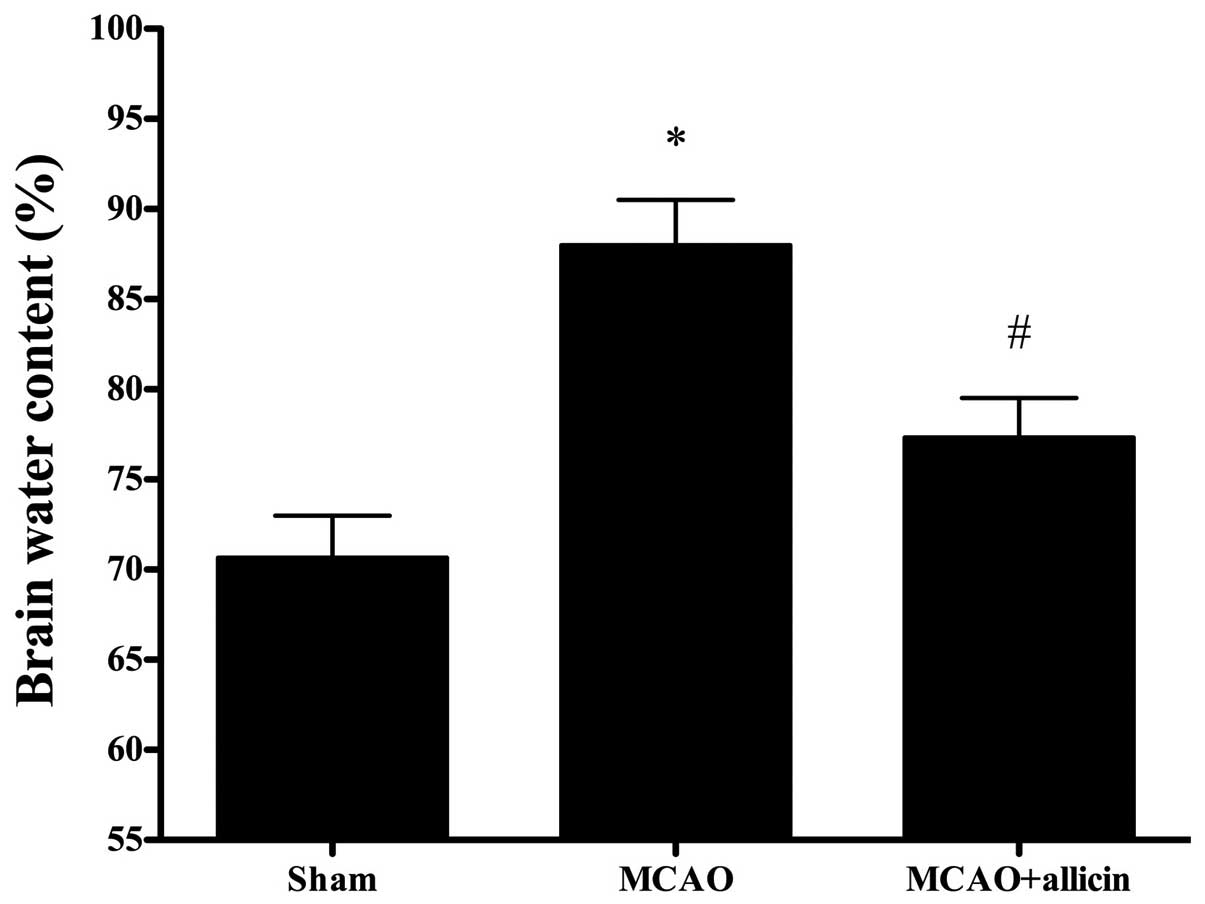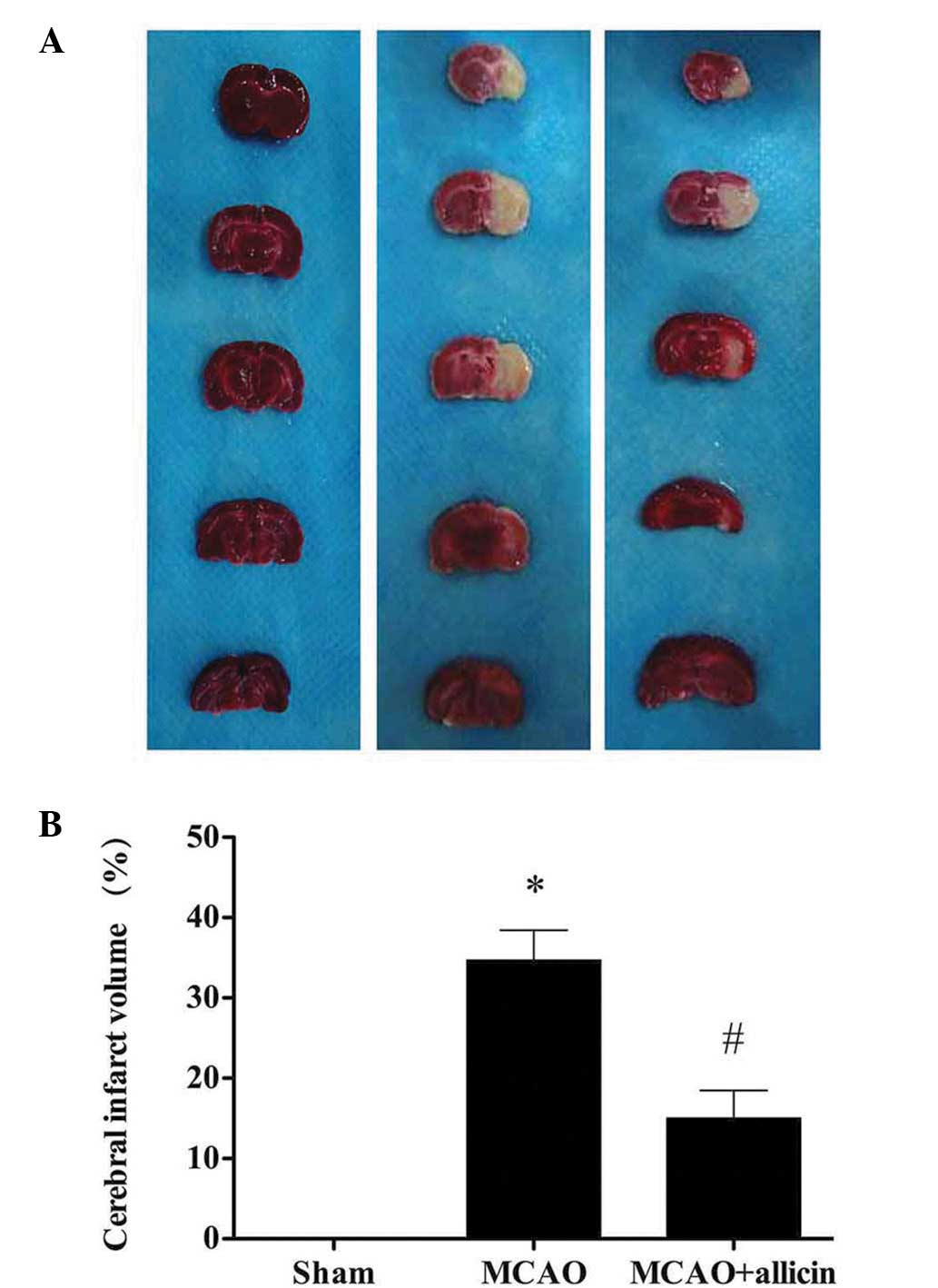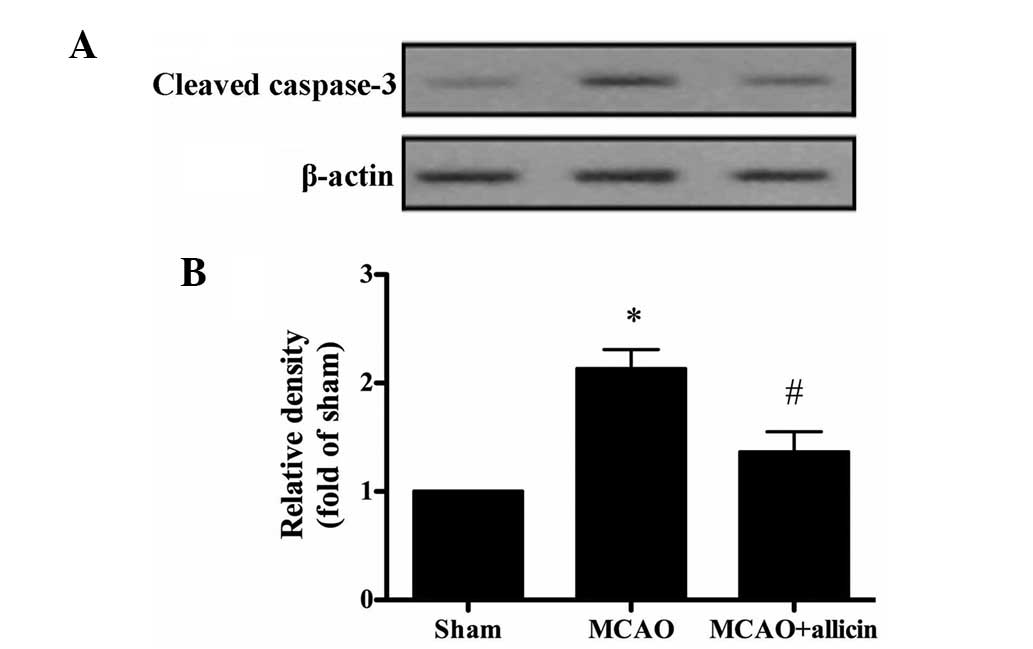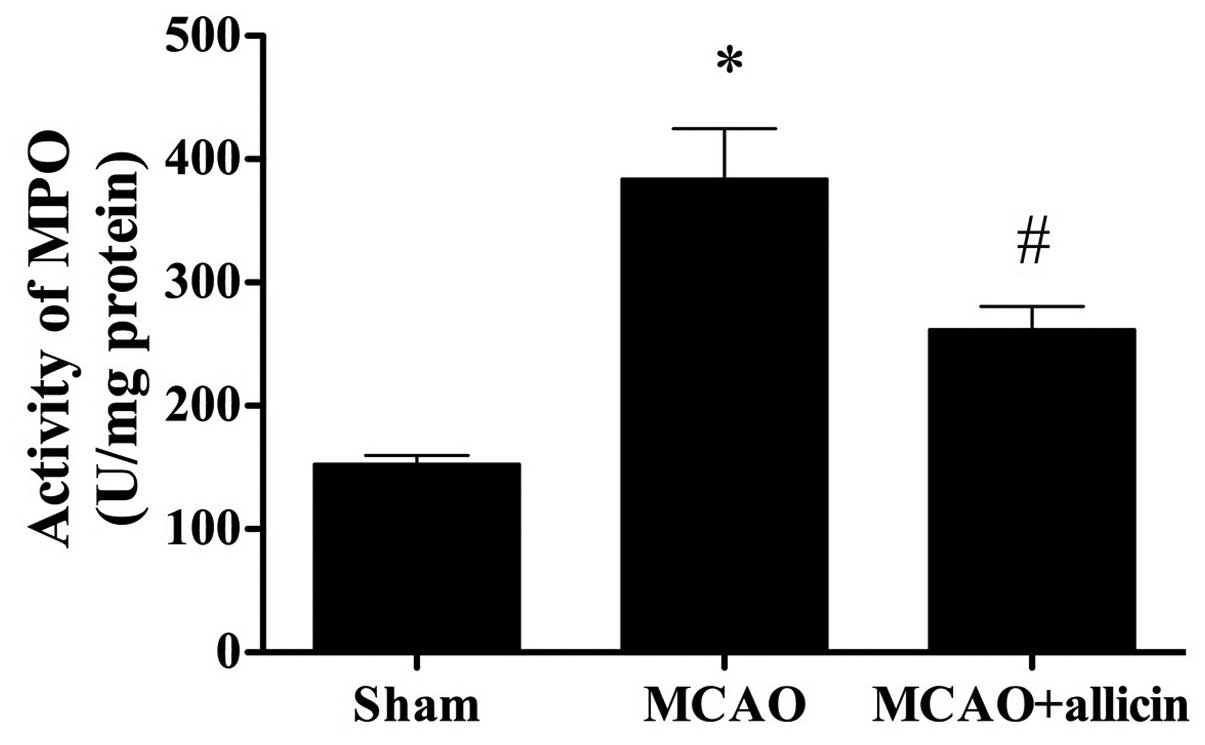Protective effects of allicin against ischemic stroke in a rat model of middle cerebral artery occlusion
- Authors:
- Published online on: June 3, 2015 https://doi.org/10.3892/mmr.2015.3883
- Pages: 3734-3738
Abstract
Introduction
Acute ischemic stroke has high rates of mortality and morbidity and is a major cause of mortality globally (1). Ischemic stroke accounts for almost 80% of all types of stroke, usually caused by a thrombotic or embolic occlusion of the middle cerebral artery or its branches (2). This occlusion triggers brain injury via a complex series of pathophysiological processes, resulting in neuronal death or neuronal apoptosis and subsequent development of neurological disorders. There is an urgent requirement for the development of neuroprotective therapies for acute cerebral ischemia, which salvage the ischemic penumbra. This strategy is reflected by the increasing use of acute re-canalization therapies, including thrombolysis (3) and the mechanical removal of clots (4). Various neuroprotective compounds have been developed to treat ischemic damage (5); however, satisfactory drug treatments in clinical practice are limited.
Allium sativum, commonly known as garlic, has been widely utilized globally as a condiment. Previous studies have suggested possible medicinal applications and health benefits of garlic (6,7). In addition, garlic has been used for a long time in Traditional Chinese Medicine in the treatment of various diseases (8).
Allicin (diallyl thiosulfinate), known as one of the most active components of garlic, is responsible for the typical smell and numerous beneficial functions of garlic (9). Previous studies have demonstrated that allicin possesses a wide spectrum of pharmacological effects, including anti-inflammatory, anti-fungal, anti-oxidant and anti-tumoral activities (10,11). Allicin has also been reported to exhibit protective effects on the brain. It has been suggested that allicin mitigates traumatic brain injury (12). However, whether allicin protects the brain from ischemic injury remains to be elucidated. Therefore, the present study aimed to elucidate the effect of allicin and its underlying mechanisms of action in a rat model middle cerebral artery occlusion (MCAO).
Materials and methods
Reagents
Allicin (purity, >98%) was purchased from the National Institute for the Control of Pharmaceutical and Biological Products (Beijing, China). A tumor necrosis factor (TNF)-α ELISA kit was purchased from Beyotime Institute of Biotechnology (Shanghai, China). A myeloperoxidase (MPO) assay kit was purchased from Nanjing Jiancheng Bioengineering Institute (Nanjing, China). 2,3,5-triphenyltet-razolium chloride (TTC) was purchased from Sigma-Aldrich (St. Louis, MO, USA).
Animals
A total of 60 adult male Sprague-Dawley rats (250–300 g; 6–8 weeks-old) were purchased from the Experimental Animal Center of Harbin Medical University (Harbin, China). All animals were maintained under a 12-h light/dark regime with ad libitum access to food and water. The rats were housed at 22°C with 50% relative humidity. The animals were maintained in accordance with the Guide for the Care and Use of Laboratory Animals published by the United States' National Institutes of Health (publication no. 85–23, revised 1996; Bethesda, MD, USA). The protocol was approved by the Committee of Experimental Animals of Harbin Medical University (Harbin, China).
Preparation of MCAO model
Rats were randomly assigned to three groups: Sham-surgery group (n=20), MCAO group (n=20) and MCAO + allicin group (n=20). The rats were anesthetized intraperitoneally (i.p.) with chloral hydrate (350 mg/kg; Beyotime Institute of Biotechnology). Subsequently, the rat was fixed in a supine position and a midline skin incision was made to expose the right common carotid artery, the internal carotid artery (ICA) and the external carotid artery (ECA). The MCAO was performed as described previously (13). Briefly, a 4-0 nylon monofilament (Sunbio Biotech, Beijing, China) with a head-rounded tip was inserted into the ECA and gently advanced into the ICA for ~20 mm to obstruct the blood flow of the right middle cerebral artery. After a 90-minute occlusion, the filament was withdrawn, allowing for the reperfusion for 24 h. The rectal temperature of the rat was maintained at 37°C±0.5°C using a heating pad. Rats in the sham group were subjected to the same procedure, with the exception of the MCAO. Allicin was administered at a dose of 50 mg/kg i.p. 3 h after reperfusion daily for five consecutive days. Allicin was dissolved in 2% dimethyl sulfoxide (DMSO; Sigma-Aldrich). Rats in the sham and MCAO groups were injected with an equal volume of DMSO.
Neurological score
The neurological score was assessed by an observer blinded to the animal groups after 24 h reperfusion according to previously described methods (14). The neurological deficits were evaluated on a five-point scale as follows: No neurological deficits = 0; failure to fully extend left paw = 1; circling to the left = 2; falling to the left = 3; no spontaneous walking and depressed levels of consciousness = 4.
Evaluation of brain water content
At 24 h after MCAO, the brain water content was detected according to a previously described method (15). The rats were sacrificed by deep anesthesia with chloral hydrate (350 mg/kg, i.p.) and brains were immediately removed and placed on a frozen plate. Tissue samples were collected from infarct areas of ischemic rats and from the corresponding areas in the sham-surgery rats. The samples were weighed to determine the wet weight. Subsequently, samples were dried in a desiccating oven at 110°C for 24 h and then weighed to determine the dry weight. The brain water content was calculated using the following formula: brain water content (%) = (wet weight − dry weight) ×100%/wet weight.
Evaluation of infarct size
The animals were sacrificed 24 h after reperfusion (n=6 in each group) by deep anesthesia with chloral hydrate (350 mg/kg, i.p.). The brains were rapidly removed and cut into five coronal sections (2 mm). The sections were incubated in a solution of 2% TTC at 37°C for 30 min. The infarct sizes were measured using ImageJ software version 1.6 (National Institutes of Health).
Immunohistochemistry
At 24 h after reperfusion, the rats were anesthetized and transcardially perfused with saline, followed by 4% paraformaldehyde (Beijing Solarbio Science & Technology Co., Ltd., Beijing, China) in phosphate-buffered saline. Subsequently, the samples were dehydrated in a graded series of ethanol and embedded in paraffin (Leica Biosystems, Wetzlar, Germany). Following epitope retrieval at 120°C for 5–10 min using citrate buffer (10 mM citric acid, 0.05% Tween 20; pH 6.0), the sections were incubated with 3% H2O2 for 15 min and then with 5% bovine serum albumin (Beyotime Institute of Biotechnology) for 1 h. The sections were then incubated with primary mouse monoclonal neuronal nuclei (NeuN) antibody (1:100; cat. no. MAB377; EMD Millipore, Billerica, MD, USA) overnight at 4°C, followed by incubation with goat anti-mouse secondary antibody (1:1,000; P044701; Dako, Carpinteria, CA, USA) for 30 min at 37°C. The immunoreactivity was visualized using a Dako Envision system-horseradish peroxidase kit (Dako). Finally, counterstaining was performed using hematoxylin (Beyotime Institute of Biotechnology). NeuN-positive staining in the cortex was identified by the presence of deep brown staining of cells specifically localized to the nucleus (TI-S; Nikon Corporation, Tokyo, Japan). The images were analyzed using the Image-Pro plus 6.0 image analysis system (Media Cybernetics, Inc., Rockville, MD, USA).
Western blot analysis
Total proteins of the cortex were extracted and quantified according to the bicinchoninic acid protein assay kit (Beyotime Institute of Biotechnology). The protein samples were subjected to 8% SDS-PAGE (Beijing Solarbio Science & Technology Co., Ltd.) followed by electrotransfer onto polyvinylidene difluoride membranes (Millipore, Boston, MA, USA). Subsequently, the membranes were blocked with 5% non-fat milk for 2 h at room temperature. The membranes were then incubated overnight at 4°C with the rabbit anti-cleaved caspase-3 polyclonal antibody (1:1,000; cat. no. 9661; Cell Signaling Technology, Inc., Danvers, MA, USA) and with rabbit anti-β-actin polyclonal antibody (1:3,000; sc-7210; Santa Cruz Biotechnology, Inc., Dallas, TX, USA), followed by three washes with Tris-buffered saline with Tween-20 (TBST; Beijing Solarbio Science & Technology Co., Ltd.). Subsequently, the membranes were incubated with the secondary antibody (1:5,000; Sc-2004; goat anti-rabbit immunoglobulin G-horseradish peroxidase; Santa Cruz Biotechnology, Inc.) for 2 h at room temperature, followed by three washes with TBST. Finally, the bands were detected via chemiluminescence with the ECL Plus western blotting detection kit (EMD Millipore). Blots were analyzed using the Bio-Rad Imaging software (Bio-Rad Laboratories, Inc., Hercules, CA, USA) and Quantity One software package version 4.6.2 (Bio-Rad Laboratories).
Measurement of serum TNF-α
At 24 h after the MCAO, blood samples (1 ml) were harvested from the femoral vein. Following centrifugation at 1,000 × g for 15 min, the supernatant was collected and stored at −80°C. Serum TNF-α was assayed using a TNF-α ELISA kit according to the manufacturer's instructions.
Evaluation of MPO
Following reperfusion, brain tissue from the penumbral cortex was immediately harvested and stored at −80°C. The brain tissue was homogenized in ice-cold phosphate-buffered saline. Subsequently, the homogenate was centrifuged at 1,000 × g for 15 min. MPO was detected using an MPO kit according to manufacturer's instructions (Nanjing Jiancheng Bioengineering Institute).
Statistical analysis
Values are expressed as the mean ± standard deviation. Statistical analyses were performed using the SPSS 16.0 software package (SPSS, Inc., Chicago, IL, USA). Data analysis was performed by one-way analysis of variance, followed by a least significant difference-t-test for inter-group comparisons. P<0.05 was considered to indicate a statistically significant difference.
Results
Allicin ameliorates neurological deficits following MCAO
As shown in Fig. 1, the rats in the sham group did not exhibit any neurological deficits, while the MCAO rats exhibited severe neurological deficits according the neurological scoring system. Allicin treatment markedly ameliorated the neurological deficits compared with those in the MCAO group (P<0.05).
Allicin decreases brain edema following MCAO
At 24 h after MCAO, the brain water content of the MCAO rats was markedly higher than that of the sham-surgery rats. Treatment with allicin significantly decreased brain edema compared with those in the MCAO group (P<0.05; Fig. 2).
Allicin reduces the brain infarct volume following MCAO
The rats in the sham group did not exhibit any infarct area in the brain, while in the MCAO group, a clear infarction was observed. Following treatment with allicin, the infarct volume in the MCAO + allicin group was significantly lower compared with that in the MCAO group (P<0.05; Fig. 3).
Allicin rescues neuronal survival following MCAO
Compared with the sham group, the number of NeuN-positive neurons was significantly decreased in the MCAO group. The decrease of NeuN-positive neurons was attenuated by allicin treatment (P<0.05; Fig. 4).
Allicin inhibits cerebral ischemia-induced neuronal apoptosis
To identify whether the neuroprotective effect of allicin was associated with its anti-apoptotic activity, the levels of cleaved caspase-3 were assessed. Compared with those in the sham group, the levels of cleaved caspase-3 were significantly increased in the MCAO group. Of note, allicin markedly decreased the levels of cleaved caspase-3 (P<0.05; Fig. 5).
Allicin attenuates increases in serum levels of TNF-α following MCAO
A cerebral ichemia/reperfusion (I/R) injury causes the production of TNF-α (16). Thus, the levels of serum TNF-α were assessed. Fig. 6 shows that, compared with the MCAO group, allicin significantly decreased the serum levels of TNF-α (P<0.05).
Allicin attenuates increases in MPO activity following MCAO
As indicated in Fig. 7, the MPO activity in the sham group was at a normal level, while that in the MCAO group was markedly elevated (P<0.05). Of note, treatment with allicin significantly lowered cerebral MPO activity (P<0.05).
Discussion
In the present study, it was demonstrated that allicin exerted a neuroprotective effect against cerebral I/R injury. Treatment with allicin significantly ameliorated neurological deficits, decreased the cerebral infarct area, as well as attenuated neuronal death, apoptosis and inflammation. Therefore, the results of the present study suggested that allicin may be of therapeutic value in the treatment of ischemic stroke.
In the signaling pathways involved in apoptosis, ischemia induces the translocation of B-cell lymphoma 2-associated X protein into the outer membrane of the mitochondria, leading to the release of cytochrome C from the mitochondria to the cytoplasm. This process causes the activation of pro-caspase-3 into active caspase-3 (cleaved caspase-3), a critical executioner of apoptosis (17), triggering apoptosis (18,19).
Apoptosis, induced by cerebral I/R injury, is one of the major causes of cell death in the ischemic penumbra (20). The infarct size is determined by the number of apoptotic neurons in the penumbra (21). Therefore, inhibiting apoptosis in the ischemic penumbra may be a promising therapeutic target for mitigating cerebral infarct size following cerebral I/R injury. In the present study, the number of NeuN-positive cells in the MCAO group was significantly decreased, while it was markedly increased following allicin treatment. In addition, cleaved caspase-3 levels were increased in rats subjected to MCAO, which was attenuated by allicin treatment. Therefore, the results of the present study demonstrated that allicin has anti-apoptotic effects.
In addition, inflammation is critical in brain injury and infarction induced by cerebral ischemia. During inflammation, inflammatory cytokines and cells are of great significance. Inflammation-associated cytokines include pro- and anti-inflammatory cytokines according to their ability to activate or inhibit inflammation (22). Important pro-inflammatory cytokines, including TNF-α, interleukin (IL)-1β and IL-6, are responsible for the initiation of inflammatory reactions and inducing the expression of other cytokines following I/R injury (23). In the present study, allicin markedly reduced TNF-α and MPO activity, indicating that allicin protects the brain from ischemia via an anti-inflammatory pathway.
In conclusion, the present study indicated that allicin has a protective effect against cerebral I/R injury in rats, which may be ascribed to its anti-inflammatory and anti-apoptotic properties. The findings of the present study provided further insight into the mechanism by which allicin exerts its neuroprotective effects and paved a way for the development of a novel therapeutic target in the clinical treatment of cerebral ischemic stroke.
References
|
Saito T, Nito C, Ueda M, et al: Continuous oral administration of atorvastatin ameliorates brain damage after transient focal ischemia in rats. Life Sci. 94:106–114. 2014. View Article : Google Scholar | |
|
Durukan A and Tatlisumak T: Acute ischemic stroke: Overview of major experimental rodent models, pathophysiology, and therapy of focal cerebral ischemia. Pharmacol Biochem Behav. 87:179–197. 2007. View Article : Google Scholar : PubMed/NCBI | |
|
Hacke W, Kaste M, Bluhmki E, et al ECASS Investigators: Thrombolysis with alteplase 3 to 4.5 hours after acute ischemic stroke. N Engl J Med. 359:1317–1329. 2008. View Article : Google Scholar : PubMed/NCBI | |
|
Smith WS, Sung G, Saver J, et al Multi MERCI Investigators: Mechanical thrombectomy for acute ischemic stroke: Final results of the Multi MERCI trial. Stroke. 39:1205–1212. 2008. View Article : Google Scholar : PubMed/NCBI | |
|
Katsura K, Suda S, Abe A, Kanamaru T, Toda Y and Katayama Y: Brain protection therapy in acute cerebral infarction. J Nippon Med Sch. 79:104–110. 2012. View Article : Google Scholar : PubMed/NCBI | |
|
Asdaq SM: Antioxidant and hypolipidemic potential of aged garlic extract and its constituent, s-allyl cysteine, in rats. Evid Based Complement Alternat Med. 2015:3285452015. View Article : Google Scholar : PubMed/NCBI | |
|
Arreola R, Quintero-Fabián S, López-Roa RI, Flores-Gutiérrez EO, Reyes-Grajeda JP, Carrera-Quintanar L and Ortuño-Sahagún D: Immunomodulation and anti-inflammatory effects of garlic compounds. J Immunol Res. 2015:4016302015. View Article : Google Scholar : PubMed/NCBI | |
|
Ginter E and Simko V: Garlic (Allium sativum L.) and cardiovascular diseases. Bratisl Lek Listy. 111:452–456. 2010.PubMed/NCBI | |
|
Lawson LD and Gardner CD: Composition, stability, and bioavailability of garlic products used in a clinical trial. J Agric Food Chem. 53:6254–6261. 2005. View Article : Google Scholar : PubMed/NCBI | |
|
Hunter R, Caira M and Stellenboom N: Thiolsulfinate allicin from garlic: Inspiration for a new antimicrobial agent. Ann NY Acad Sci. 1056:234–241. 2005. View Article : Google Scholar | |
|
Chan JY, Tsui HT, Chung IY, Chan RY, Kwan YW and Chan SW: Allicin protects rat cardiomyoblasts (H9c2 cells) from hydrogen peroxide-induced oxidative injury through inhibiting the generation of intracellular reactive oxygen species. Int J Food Sci Nutr. 65:868–873. 2014. View Article : Google Scholar : PubMed/NCBI | |
|
Zhou YF, Li WT, Han HC, et al: Allicin protects rat cortical neurons against mechanical trauma injury by regulating nitric oxide synthase pathways. Brain Res Bull. 100:14–21. 2014. View Article : Google Scholar | |
|
Ye R, Yang Q, Kong X, et al: Ginsenoside Rd attenuates early oxidative damage and sequential inflammatory response after transient focal ischemia in rats. Neurochem Int. 58:391–398. 2011. View Article : Google Scholar | |
|
Longa EZ, Weinstein PR, Carlson S and Cummins R: Reversible middle cerebral artery occlusion without craniectomy in rats. Stroke. 20:84–91. 1989. View Article : Google Scholar : PubMed/NCBI | |
|
Hatashita S, Hoff JT and Salamat SM: Ischemic brain edema and the osmotic gradient between blood and brain. J Cereb Blood Flow Metab. 8:552–559. 1988. View Article : Google Scholar : PubMed/NCBI | |
|
Saad MA, Abdelsalam RM, Kenawy SA and Attia AS: Montelukast, a cysteinyl leukotriene receptor-1 antagonist protects against hippocampal injury induced by transient global cerebral ischemia and reperfusion in rats. Neurochem Res. 40:139–150. 2015. View Article : Google Scholar | |
|
Fernandes-Alnemri T, Litwack G and Alnemri ES: CPP32, a novel human apoptotic protein with homology to Caenorhabditis elegans cell death protein Ced-3 and mammalian interleukin-1 beta-converting enzyme. J Biol Chem. 269:30761–30764. 1994.PubMed/NCBI | |
|
Lee Y and Gustafsson AB: Role of apoptosis in cardiovascular disease. Apoptosis. 14:536–548. 2009. View Article : Google Scholar : PubMed/NCBI | |
|
Crow MT, Mani K, Nam YJ and Kitsis RN: The mitochondrial death pathway and cardiac myocyte apoptosis. Circ Res. 95:957–970. 2004. View Article : Google Scholar : PubMed/NCBI | |
|
Mattson MP, Duan W, Pedersen WA and Culmsee C: Neurodegenerative disorders and ischemic brain diseases. Apoptosis. 6:69–81. 2001. View Article : Google Scholar : PubMed/NCBI | |
|
Broughton BR, Reutens DC and Sobey CG: Apoptotic mechanisms after cerebral ischemia. Stroke. 40:e331–e339. 2009. View Article : Google Scholar : PubMed/NCBI | |
|
Chen T, Liu W, Chao X, et al: Salvianolic acid B attenuates brain damage and inflammation after traumatic brain injury in mice. Brain Res Bull. 84:163–168. 2011. View Article : Google Scholar | |
|
Yasuda Y, Shimoda T, Uno K, et al: Temporal and sequential changes of glial cells and cytokine expression during neuronal degeneration after transient global ischemia in rats. J Neuroinflammation. 8:702011. View Article : Google Scholar : PubMed/NCBI |
















